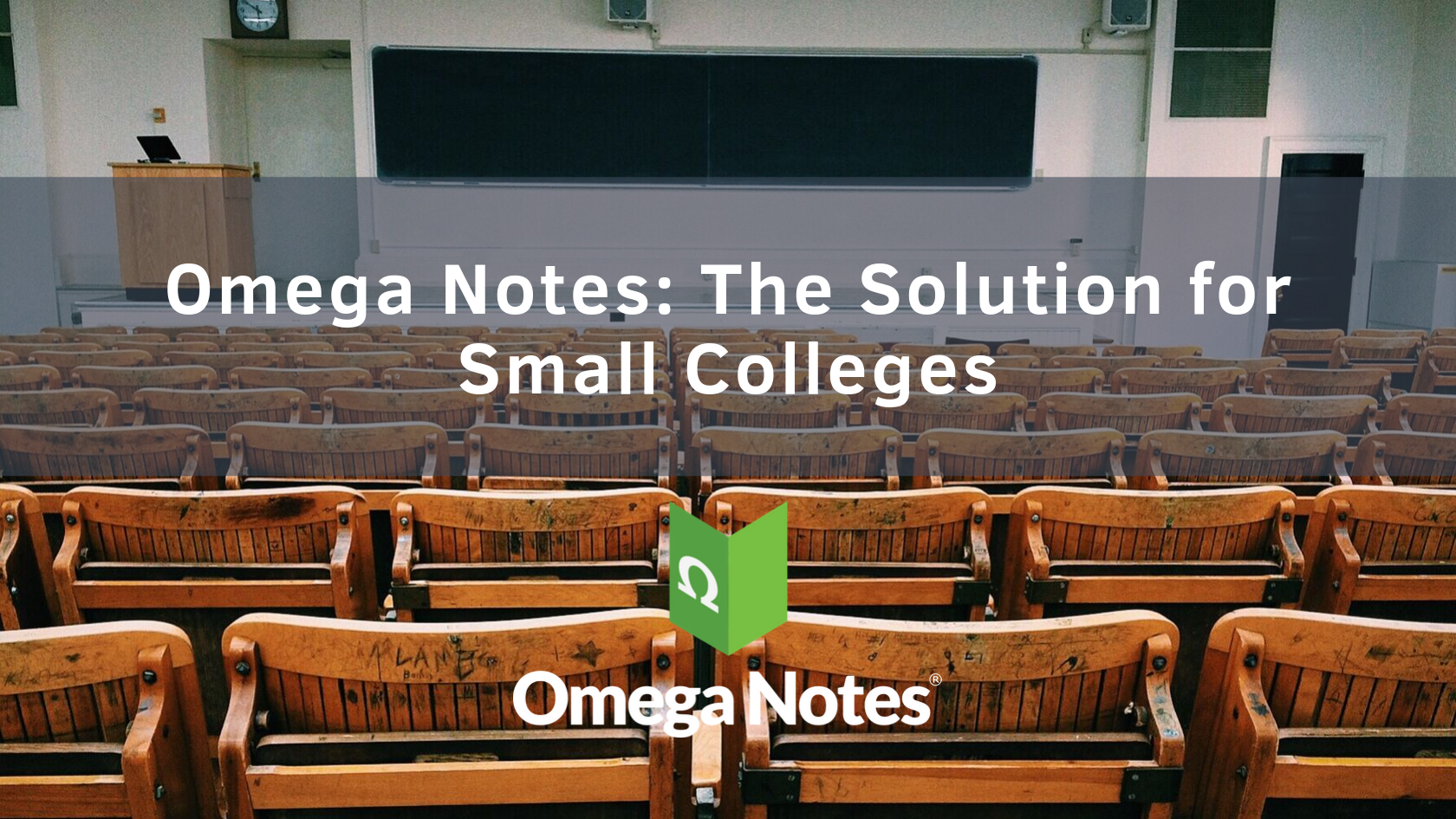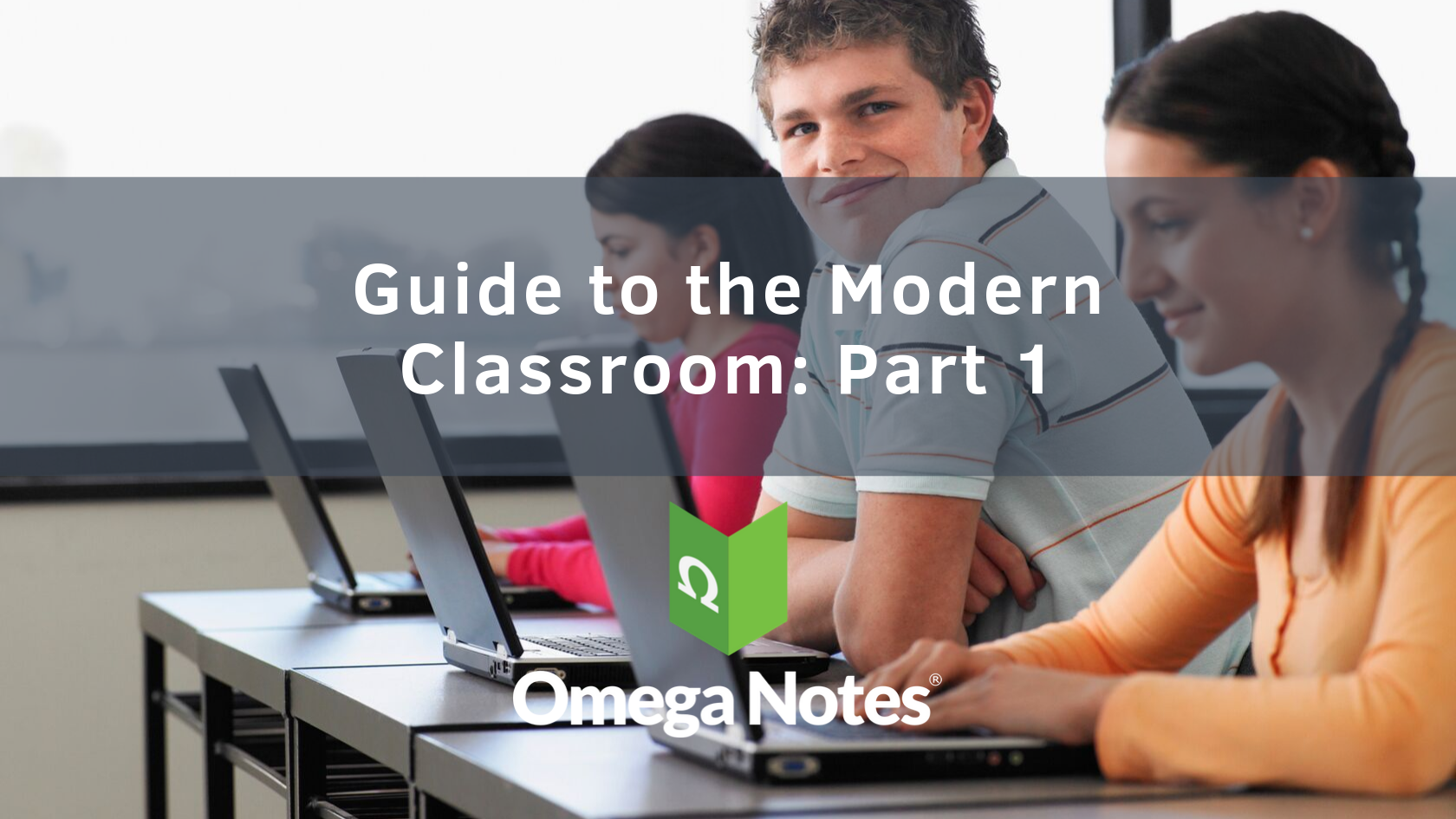Always ON™ Higher Education
The official blog of Omega Notes
Omega Notes: The Solution for Small Colleges
In a recently published article by the WSJ, Jon Kamp’s reports on the closure of Green Mountain College, a nearly 200 year-old college in Vermont. The closure follows a trend that can be witnessed throughout the country.
A steep decline in student enrollment is often cited as the primary reason behind the struggle of small liberal arts colleges. However, nationwide enrollment numbers show that students still see the benefits of a college degree as wage data indicates that college graduates, regardless of degree, significantly out-earn their non-college educated peers. In absolute terms, college enrollment has declined since the admission spike in 2007 and 2008, but continues to remain well above pre-2005 levels.
If overall enrollment numbers haven’t drastically changed, then why are students turning away from smaller colleges such as Green Mountain College? A quick analysis of freshman retention rates shows that liberal arts colleges have, on average, lower retention rates than national universities. Data also indicates that admissions to flagship institutions are well above their enrollment goals, a stark contradiction to the significant admission shortfall faced by Green Mountain College.
College retention and growth is a multifaceted problem driven by concerns of higher education affordability, the lack of effective tools to adapt to the demands of a personalized learning experience, and the slow rate at which institutions are investing in a culture increasingly focused on digital learning and collaboration. These factors are only exacerbated for small colleges and universities unable to afford the financial impact of a modern technology infrastructure. Omega Notes, a small Pennsylvania based start-up located in State College, feels that they have a solution.
Omega Notes is designed to improve student outcomes and combat declining retention rates. They claim smaller liberal arts colleges stand to benefit the most from the Omega Notes platform. Students have grown accustomed to using technology in all aspects of their lives, including the college classroom. A 2015 survey showed that over 75% of students preferred reading course material with a digital device yet many institutions have yet to modernize to meet this demand. Colleges that are reluctant to embrace technological change get left behind and lose favor amongst students.
With the use of advanced analytics tools, the Omega Notes platform can detect students who are likely to have difficulty with the course material. Professors and academic advisors can use this information to provide extra help to students who need it most and increase their chances of completing their college degree. The platform also provides a built-in method through which students can directly reach out to their professors and seek assistance. It’s surprising that in the majority of college classrooms the only way a student can contact their professor is by writing an email.
Most higher-ed technical solutions are expensive, and thus out of reach for most small colleges. Omega Notes’ unique micro-publishing model allows students and their colleges the ability to avail significant discounts on course material that can, in turn, off-set the costs of technology adoption.
Prior to implementation by launch customers, Omega Notes went through an extensive private beta phase during which they were provided with feedback from professors, students, and administrators. This feedback was used to further develop the product to ensure that it meets the needs of the 21st century classroom. The Omega Notes platform leverages technology to increase student retention and satisfaction while simultaneously offering an affordable solution for both students and institutions alike. Adopting a cloud-based learning solution like the Omega Notes platform addresses the concerns of modern students and may help build a foundation for ailing universities to retain existing students. Furthermore, this foundation gives these colleges the ability to increase enrollment by offering a learning solution that speaks to a modern generation demanding price-conscious innovation in the classroom.
By: Matthew Compton-Clark and Saad Malik
Education and the Big Data Revolution
As development of comprehensive data analytics, machine learning, and AI continues to move forward, people’s standards of life improve as it allows us to make better decisions by observing past results. For example, Prognos can help patients by predicting and eliminating diseases while utilizing artificial intelligence, credit card company’s intelligent system can save consumers money by detecting fraudulent transactions, and Tesla’s automatic driving system can save lives by reducing the chance of automobile accident rate through AI intervention. The Omega Notes platform brings the benefits of an analytics platform into the classroom resulting in a more effective academic experience. Even though analytics systems may feel distant and confusing, the research shows that using big data to innovate education improves student outcomes.
When new analytics systems are implemented at institutions, professors have the tools to be more proactive with students and enhance their learning experience. We all know students and educators are juggling the academic responsibilities of assignments, homework, quizzes, and exams. As such, it can be difficult to monitor where and why students may be struggling or disengaged. When an analytics system is implemented, an environment can be created where everyone can optimize their time in and outside of the classroom by focusing on content students are struggling with.
There are several ways analytics systems can be utilized to improve the learning process. For instance, they can suggest what material an instructor may need to cover in class based on student comprehension. Or, a student matching algorithm could even recommend study partners or tutors by matching students with each other based on assessment results.
At Omega Notes, we believe that all students deserve to have access to resources that will enhance their learning experience and prepare them for the real world. Omega Notes provides students, faculty, and administrators with a robust, cloud-based Collaborative Learning System (CLS) with tools that enable them to gather and assess data relevant to the learning process. Faculty members can create interactive eBooks using Course Packs, which allow them to fully customize the material for their students to use. In these eBooks, professors can monitor student progress and study time. Using these analytics, professors can see trends in their students’ study habits and determine how they reflect in their performance on assignments and exams. If students aren’t spending enough time reviewing specific sections of the course material, professors can notify them to take necessary actions, such as looking over notes on those sections or finding an appropriate study partner. Course Packs allow professors to have flexibility in the way they teach and the way their students learn.
Omega Notes aims to provide institutions with essential analytic resources so they can take the next step in evolving our education systems. To learn more about our services, please visit our website at www.omeganotes.com or contact us at info@omeganotes.com.
By Junwon Choi and Jeffrey Chin
Real-time Collaboration: The Next Frontier in Ed Tech
Web-based learning and assessment platforms are steadily becoming more important in college classrooms. The rise in the availability of ebooks has made it easy for professors to pick a textbook without concerning themselves with issues such as physical weight, availability in the university library or inventory requirements at the local bookstore. In some cases, these ebooks can even be integrated with a university’s learning platform. The integration provides new opportunities for all stakeholders. Students can collaborate with their classmates online while they consume the ebook. Professors can keep track of this collaboration and identify students who might be in need of assistance or pick topics that need to be reinforced in the classroom. For administrators, collaboration can be used as a predictor of classroom success.
Research has repeatedly shown that on average, “groups” are more efficient at solving complex tasks when compared with individuals. Every person has a unique way of thinking. When students have the opportunity to interact with each other, they are able to draw more in-depth conclusions than they would be able to individually. Problems are easier to solve when you have broader perspectives as each student has a unique background.
Developing a product that focuses on real-time collaboration, in an education context, presents certain unique challenges. From the student’s perspective, real-time collaboration may just be a fancy word for direct messaging. Thus in student focus groups, participants find it difficult to find value in various collaboration technologies. So how can Edtech firms stand out? At Omega Notes, we believe that integration is king. Edtech developers must ensure that no feature, no matter how advanced, disrupts user workflow. In other words, the best tech is also the least visible. The Notebook by Omega Notes is seamlessly integrated into our Course Packs platform. What does seamless integration mean? We wanted to make it extremely easy for students to collaborate in real-time while they consume course material. A major flaw of old-school collaboration platforms such as (Google Docs, Online Chat, etc.) is that they require the student to navigate to a different window or tab. We felt that doing so interrupted the learning process. The Notebook panel is highlighted in yellow in the image below. Students can collaborate with peers or even interact with their professor without navigating away from the course content.
Making the Case
Product designers need to make the case for highly integrated collaboration platforms. And ultimately, the case needs to be made to professors. With the increased adoption of online learning resources, convincing professors is a much easier task. When course material is consumed digitally, it makes it possible to collect accurate analytics regarding student learning habits. We can now show professors that real-time collaboration results in higher rates of student success. With actual numbers, we can quantify the benefits of real-time collaboration.
References
John Kania & Mark Kramer, Collective Impact, SSIR, https://ssir.org/articles/entry/collective_impact#
Matt Davis, How Collaborative Learning Leads to Student Success, Edutopia, https://www.edutopia.org/stw-collaborative-learning-college-prep
Guide to the Modern Classroom: Part 3
Collaboration: The Smarter Way to Learn
Have you ever noticed that when you study with your friends, you tend to do better on exams and more fully understand the material? This result is more than just a coincidence; collaboration in an (appropriate) group setting has been proven to help students more effectively understand a wide array of subjects such as mathematics and literature. Bouncing ideas off other people and attempting to explain concepts helps the brain make the jump from simple memorization to understanding and applying those concepts. Almost every professor I’ve ever had has told the class to do those very things, but when you don’t know anyone in the class, it can seem almost impossible.
That’s why Omega Notes focuses on creating a seamless learning environment that makes collaboration an important part of the user experience. The Omega Notes Notebook allows you to view other students public notes, flashcards, and questions. By asking and answering questions with students in your class or using your same textbook, you can get answers quickly without waiting for office hours or buying an expensive CourseHero account. The process is simple, when you sign up for an Omega Notes account you are given access to the full capabilities of the Notebook.
That’s not all! Omega Notes is the premier note-sharing platform for college students. Students have an incentive to take notes in class and share their notes with peers. Unlike some other services out there, Omega Notes does not require a subscription. In fact, the price that you see for a document is the price you pay. We never charge any hidden fees. You’d be happy to hear that students have made upwards of $1000 in a matter of months, just by selling notes to their peers. Go on, create your Omega Notes account today.
When you use Omega Notes in your class, you can finally stop memorizing and start learning (and earning!).”
Guide to the Modern Classroom: Part 2
Learning: Use Tech to Take Better Notes
The Calendar, coupled with cloud-storage have hopefully helped a great deal with organization. Now, you find yourself in class, ready to start taking notes. This blog will detail which word processor is ideal for the modern classroom, we’ll even go over some best practices when taking notes. Material pertaining to a class (lecture slides, graphs, etc.) are best stored in the cloud services mentioned in Part 1. However, what about the actual note taking? Which software works best when it comes to effectively writing down what’s being taught without actually losing focus.
This is where the Omega Notes Notebook comes into play. The Omega Notes Notebook is free to use for anyone with an Omega Notes Account (Also Free!). The Notebook stands out because it was made specifically for taking notes on your laptop during a lecture.
Why does it work?
- Each note that you take can be neatly organized by class or section.
- A split screen view makes sure that your previous notes are still partially in view. Thus, allowing easy access in case your professor asks you to recall something he/she previously mentioned.
- The Notebook allows you to create class-specific flashcards which makes exam-prep a lot more efficient.
How should I use the Notebook?
- Login to Omega Notes and open the Notebook. Before the lecture starts, enter in the course name (You don’t have to worry about the date).
- If it’s your first time with the notebook, be sure to familiarize yourself with all the writing tools at your disposal.
- Focus on the lecture. Note-taking should never come at the expense of understanding the material that is being taught.
- At the end of class, go to your calendar and make a note of the topics covered in class today.
It’s important to understand that the sole purpose of the Notebook is to help students. Many other word processors have features that students simply do not use. These excess features may slow down your laptop and make the note-taking experience more cumbersome.
Create an account on Omega Notes today and start taking quality notes!
Guide to the Modern Classroom: Part 1
Organization: The First Step to Better Learning
For most college students, the prospect of taking detailed notes in class can be daunting. We don’t blame them. During most lectures, professors tend to cover multiple texts and sources, making it difficult to figure out which bits of the lecture are more important than others. It’s very common for students to simply copy everything on the whiteboard without really focusing on the lecture and trying to develop the intuition behind what is being discussed.
Luckily, more and more professors are permitting the use of technology during class. We’ll discuss some ways through which students can take high-quality notes while at the same time develop an understanding of what’s being taught. Let’s start with Organization.
The Calendar
Using the calendar app should be the first step for most students. It can often become too cumbersome to open the syllabus every time you need to look at which topics were covered in class on a specific day. Towards the end of each lecture, just go to the calendar on your laptop or phone and note down the topics covered in class. Doing so would be immensely helpful when you’re preparing for an exam. In fact, using the calendar in this way will even allow you to better organize all the notes you take.
The Cloud
Be it Google Drive, iCloud or OneDrive, the cloud is the way to go when it comes to storing your notes. All three services are available on your phone, laptop and can even be accessed using a public computer. Files stored on the cloud can even be shared directly from the app, students no longer have to rely on E-mail or USD sharing. Students may create separate folders for each class that they’re taking. All material created during class will go into that class’s respective folder – making organization speedy and efficient. Towards the end of the semester, you’ll be able to sort all the material in each folder by date. This alongside the calendar will allow you to know exactly what was covered on any specific day or week.
Part 2 of this blog will be posted soon. Stay tuned.





